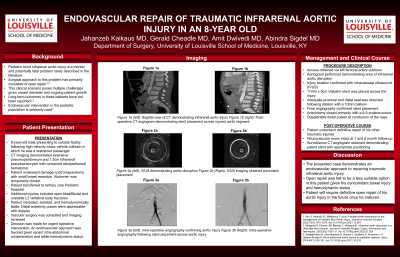Back

Vascular
Category: Quickshot Oral Session 17
Quickshot Oral : Quickshot Oral Session 17
ENDOVASCULAR REPAIR OF TRAUMATIC INFRARENAL AORTIC INJURY IN AN 8 YEAR-OLD
Monday, February 13, 2023
7:00am – 8:00am East Coast USA Time

- JK
Jahanzeb Kaikaus, MD
Resident
University of Louisville
Louisville, Kentucky, United States - AS
Abindra Sigdel, MD
United States
Presenter(s)
Principal Contact(s)
Objectives: The patient is an 8 year-old male transferred to tertiary pediatric hospital following high-speed motor vehicle collision in which he was a restrained passenger. Initial CT imaging at outside facility demonstrated a traumatic infrarenal aortic pseudoaneurysm, extensive pneumoperitoneum and free fluid, and an unstable L2 vertebral body fracture. He underwent exploratory laparotomy with small bowel resection prior to transfer, as well as external fixator placement for an open right tibial/fibular fracture. The patient was left in discontinuity and temporary closed. Vascular surgery was consulted upon arrival to children’s hospital. On examination, the patient was intubated and sedated, tachycardic, with palpable lower extremity pulses. Review of his CT scan demonstrated a disrupted, mildly dilated segment of aorta measuring 1.5cm with evidence of a contained retroperitoneal hematoma. The decision was made to proceed with emergent endovascular repair. Access was obtained via left femoral artery cutdown. An aortogram was performed confirming location of the aortic disruption well below the renal arteries, superior to the bifurcation. An 11mm x 5cm Viabahn covered stent was placed across the injury with adequate proximal and distal seal following dilation with a 10mm balloon. Distal pulses could be appreciated on doppler at the conclusion of the case. The patient underwent definitive repair of his numerous other injuries and was discharged 3 weeks later. His aortic repair has remained intact on 1 and 6 month follow-up visits with surveillance CT angiogram. He has returned to his normal activities, including competitive baseball.
This is a complex case of seatbelt-related pediatric infrarenal aortic injury in the setting of polytrauma. Though many of the pediatric cases described in the literature involve open repair, we felt an endovascular approach was both feasible and more appropriate in this clinical context. While the patient will ultimately require a definitive aortic repair as he matures, we were able to avoid the potential complications of graft placement in the acute setting of perforated hollow viscous. Moreover, this case highlights the feasibility of endovascular repair of aortic injuries in the pediatric patient population. Ongoing follow-up is needed to evaluate long-term outcomes as well as appropriate timing of reintervention.
Methods:
Results:
Conclusion:
This is a complex case of seatbelt-related pediatric infrarenal aortic injury in the setting of polytrauma. Though many of the pediatric cases described in the literature involve open repair, we felt an endovascular approach was both feasible and more appropriate in this clinical context. While the patient will ultimately require a definitive aortic repair as he matures, we were able to avoid the potential complications of graft placement in the acute setting of perforated hollow viscous. Moreover, this case highlights the feasibility of endovascular repair of aortic injuries in the pediatric patient population. Ongoing follow-up is needed to evaluate long-term outcomes as well as appropriate timing of reintervention.
Methods:
Results:
Conclusion:

